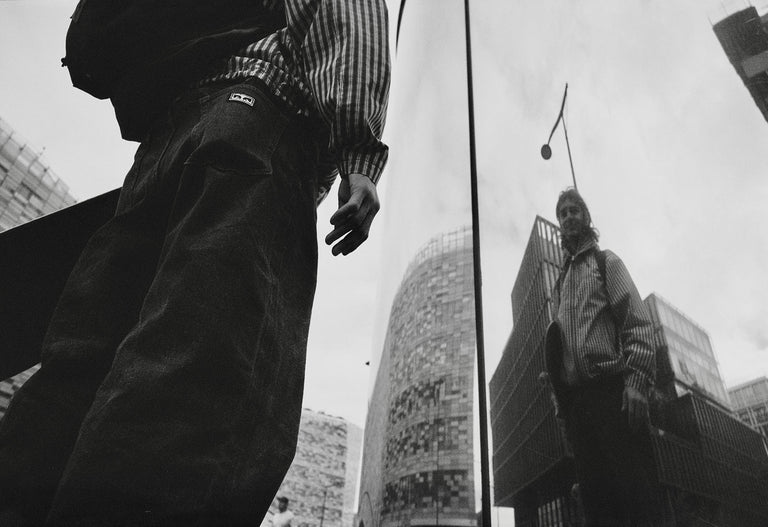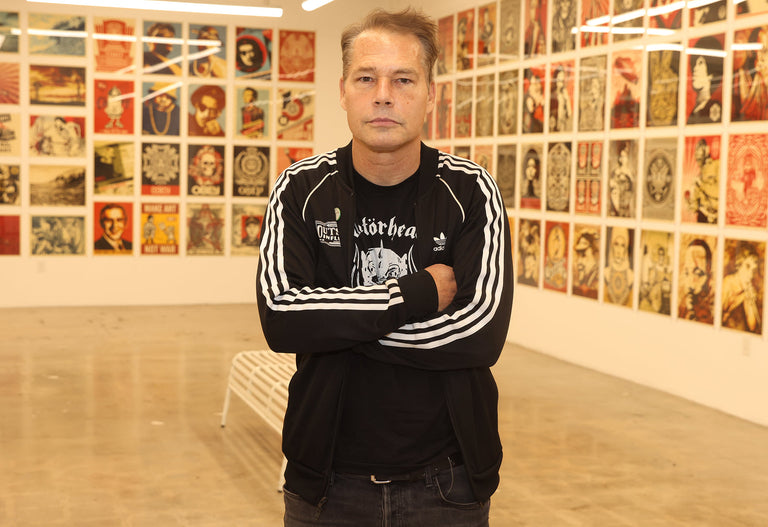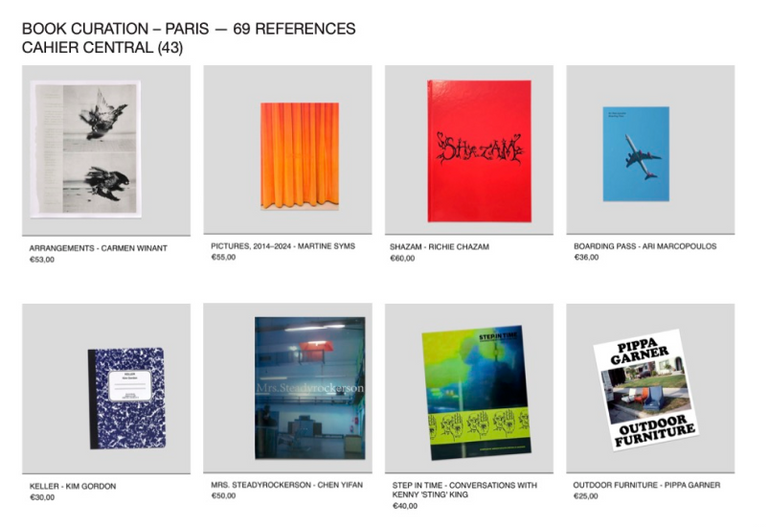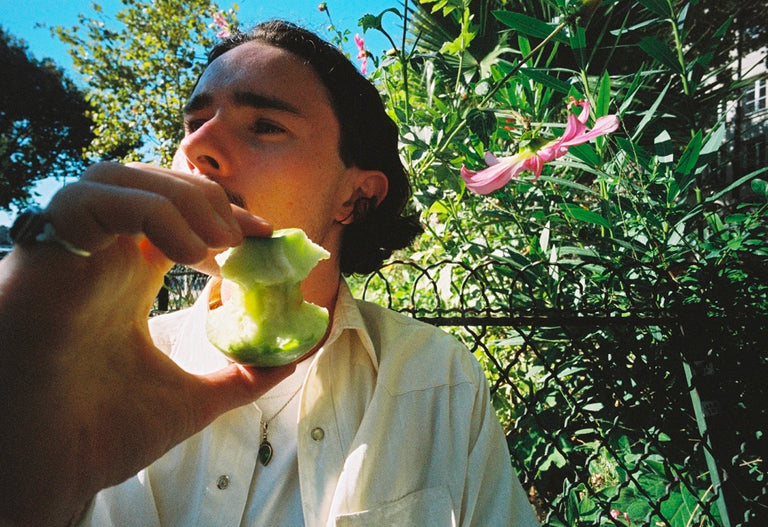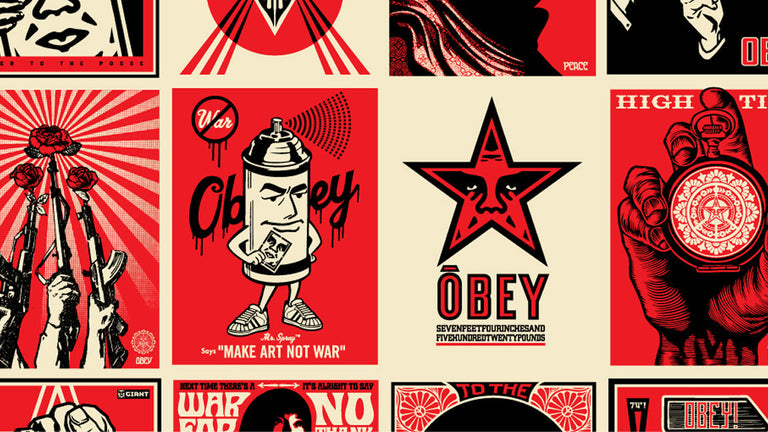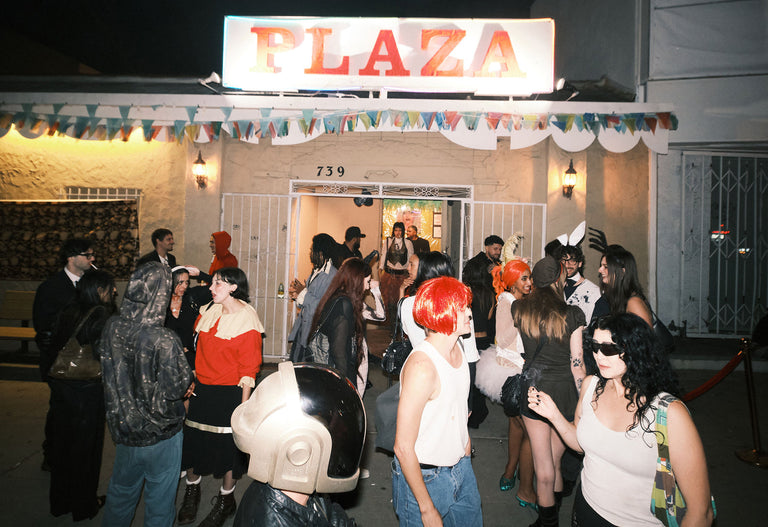 We’re proud to present a collaboration between legendary photographer Glen E. Friedman and OBEY. Glen has shot some of the most memorable and meaningful photos in skateboarding, punk rock, hip hop and more over the last 30 years. Always with an eye for perfection and living by the definition of integrity, Glen has amassed a body of work including album covers for the Beastie Boys, Public Enemy, and Suicidal Tendencies. He was there to shoot Minor Threat, Bad Brains and the DC scene. Glen was in back yard pools taking pictures of Tony Alva and the Dogtown crew as they changed skateboarding.
We’re proud to present a collaboration between legendary photographer Glen E. Friedman and OBEY. Glen has shot some of the most memorable and meaningful photos in skateboarding, punk rock, hip hop and more over the last 30 years. Always with an eye for perfection and living by the definition of integrity, Glen has amassed a body of work including album covers for the Beastie Boys, Public Enemy, and Suicidal Tendencies. He was there to shoot Minor Threat, Bad Brains and the DC scene. Glen was in back yard pools taking pictures of Tony Alva and the Dogtown crew as they changed skateboarding.
Over the years, Glen and Shepard have collaborated on a number of projects, most of which were never available on apparel. Now Glen has released a new book, My Rules, and we thought it was a perfect time to release some of those collaborations. So in support of My Rules we are releasing 4 of those works, each representing a different genre. There is Tony Alva from Dogtown and skateboarding, Henry Rollins from Black Flag, Cornell West the political activist and Public Enemy for hip hop.

Tony Alva – One of the most incredible trailblazers of the sport of all time. Alva was the first skateboarder ever inducted to the “Skateboarding Hall of Fame”, and the first Skateboarder ever voted “Skateboarder of the Year”, The first Skateboarder to do aerials in pools. A precision stylist whose influence will never diminish. Alva set standards when there were none and helped the sport progress like few others.

Henry Rollins – One of the most important punk rock front men of all time. Henry took Black Flag to popularity they had not seen before his arrival from his humble beginnings in Washington DC as one of the founders of that incredible hardcore scene. Since forming the “Rollins Band” and his own publishing company, writing for major publications and hosting culturally relevant television programming, Henry is a true renaissance man of our time.

Dr. Cornel West – A hero to many, Dr. West is a prominent and provocative, celebrated American philosopher activist, and public intellectual. He has authored more than twenty books. He has taught at Yale, Harvard, Princeton, and the University of Paris. His radical rebel status can be summarized by his admission that indeed he is “suspicious of all forms of authority”.

Public Enemy – The group who helped to forge a political and cultural awakening in Hip-Hop and culture at large, while making some of the most incredibly dynamic recordings of our time. Their second album “It Takes A Nation of Millions to Hold Us Back” is often referred to as the greatest and most important Hip-Hop album of all time. The group’s front man Chuck D. is clearly one of the most respected voices of his generation.
Friedman’s photographs are an extension of his beliefs, both social and political, and it was a privilege to spend some time with Glen during the launch week of his London ‘My Rules’ show.
Your relationship with Shepard Fairey has developed over the years and has led to some fantastic illustrated prints where Shepard has been able to amplify the powerful essence of the subjects within your images and fan the flames of your powerful photography. What was your approach to the ‘My Rules’ clothing collaboration with Shepard and OBEY Clothing?
After Shepard has turned one of my images into a graphic using bold areas of ink and not pixels it works so well. In the past I’ve been reluctant to use my work on clothing as I’ve had concerns about quality but it’s Shepard’s artistry and his company so it’s natural and just works. Ever since the fourth or fifth print collaboration I had always thought in my mind that maybe one day we’ll do an Artist Series and we’ll get them out at some point. I’m really excited and, for me, they all look cool. I don’t know if the rest of the world will understand the Cornel West significance as much as we do in the United States but all they can do is type his name on the Internet and listen to him speak and you’ll fall in love with the guy. He’s amazing!
On this project we also got more involved in the colours than usual and each one of these people that we’ve used for the graphics has a real identification with a specific colour. Together with the OBEY Clothing team we used specific colours, for example, for Tony Alva I had to get the image printed on a blue sweatshirt; he’s always been Tony ‘Blue Tile’ because of his pool skating… and it’s refreshing to have some bright colours in the collection! We also have the deep red for Henry Rollins and the olive green for Public Enemy. I like colours – it’s uplifting and exciting. The Cornel West one is going to be on heather grey just because it’s my favourite colour in clothing. I was very impressed with how it’s laid it out on the OBEY Clothing site, the collection looks beautiful. Even the swingtags look great!
I think people come and see my stuff because they’re fans of what I do and because I hold a stringent line for not selling out. I respect Shepard and I respect everything that he does and as a human I dig him and he’s smart and he’s articulate and he knows what the he’s doing! He’ll talk circles around you… in a good way! Not in a bullshit way! That’s my man.
And you reached out to Shepard for help with the ‘My Rules’ book design?
Shepard talked to me, maybe four or five years ago, about doing the books in a different way and working with an outside publisher but initially it never really felt right. More recently Shepard then actually introduced me to the editor at Rizzoli who we ended up working with. I appreciated that and it was just natural that since he was the one who introduced me then he would get the gig to help with the design.
Since Shepard and Cleon Peterson, his assistant, are skaters themselves and love punk and music and hip hop like I do and have a real understanding of skateboarding it helps to have their opinion; they’re of a different generation so it was really good to have their opinion on everything from the images chosen to the mechanics of the book.
You’ve had a long relationship working with Shepard whether working on print collaborations, the Liberty Street Project, the Idealist Propaganda show, Subliminal Projects… how did you guys first meet?
The first time we met in the flesh was when he came to my show at the Sixspace Gallery in Los Angeles where I was having the ‘Fuck You All’ show and I just got off the plane and had the news that Jam Master Jay had been murdered. Ten minutes later, coincidentally, I met Shepard just at the gallery getting a private preview because he knew the gallery owner as he was going to be out of town at the opening. I had asked him, upon hearing the horrible news about Jay, if he would help me create an image of Jam Master Jay for the show so I could put up a memorial to him and dedicate the show to his memory. He said yes even though he was going to be out of town and was clearly busy and within 48 hours it was done. He did the main graphic of Jam Master Jay’s head and face so we built the graphics around it and it was ready in time for the opening. We ended up using it for t-shirts for his memory and to raise money for the family.
Shepard has a non-stop approach to his street art and fine art projects – always piecing them together with incredible passion and drive. I guess it would have been easy for you to work together sharing the same ideals?
Yes! Absolutely. There’s a mutual respect there. Shepard’s a very articulate guy, a real craftsman and also a bit of a perfectionist. I respect all of those qualities immensely. He’s not just throwing shit out there he’s very political. I’d call him a really strong liberal and I have a lot of respect for that and we need more people like that. He speaks throughout almost all of his art and I respect it immensely.
His political statements have always been the most important thing to me. He’s not an idiot. He’s not bullshitting. He has very specific ideas about what he wants to do and he is a bit of a perfectionist, even when it comes to his street pieces and I’ve seen him get mad at some of his assistants. He’s worse than me! He’s a really picky guy. That’s why I never got into film and those types of things. I didn’t want to have to boss people around and tell people what to do. If I needed something done right I know I could do it myself. Shepard’s projects are so massive in scale that he couldn’t possibly do them by himself.
When we do our collaborations on the prints I don’t just give him the photo and he does his thing to it… that’s a big part of it… but we talk together about it and he’ll ask me what I think or sometimes I’ll just tell him ‘this is my vision for this. I want Keith Morris to write the song lyrics in the background’. I wanted certain symbolism to be in the Cornel West image and for Tony Alva I wanted Shepard to do a different colourway and to keep with the ‘Tony Blue Tile’ theme. I thought it would separate it from everything else and be great to have a different pallet.
There have been some fantastic images such as Bad Brains, Rollins, Cornel West, Jim Muir, Keith Morris, Tony Alva and most recently Jello Biaffra… but what’s been your favourite project that you’ve worked on with Shepard?
The most important thing that we ever did was with the Liberty Street Protest. His suggestions were monumental. He really helped me hone the message and really get it to a place where it needed to be. He gave me great advice on that and laid it all out, to a degree, as he knew how important it was going to be. The building hadn’t been open for three years since 9/11; we went there in time for the Republican convention coming to town and it was great… his suggestions were invaluable. I kicked ass, installed the thing and made it all happen… it was all my idea but his advice really made it work. It gave it the strength.
Image-wise I think we’re going to be working on more – we’re currently working on the Pussy Riot image for hopefully early in 2015. They’re really cool women and they really wanted to do it. I want to do it too! I thought it would be cool. I came to them with the idea and they were like ‘hell yeah!’ they like Shepard’s work a lot together with the Russian constructivist inspiration that he uses sometimes. It would be just great, we could exaggerate that, that’s my two cents that I’m throwing in! We’ll see where it goes from my photo but hopefully it will come to fruition.
As a spectator of the launch night it was impossible for me not to notice the connection that your audience have with your work; seeing the excitement on the faces of this wide spectrum of people coming through the door who’ve been influenced by punk, hip hop and skateboarding was only enhanced by your presence and willingness to explain more details about each photograph. Is that a particularly enjoyable part of being here?
Well if I see someone looking at a picture trying to figure out what’s going on I just want to make sure that, whilst I’m here, I let them know what I was thinking about it. If someone seems interested in my work then I’ll give them a little bit more and try add to the story… but that’s a good question… I like the work to do its own thing but I also want people to like the books and I want them to like the photographs too. You can see more in the actual prints than you do in the book because some of the pictures are a little cropped in the book. I think that the show really has a lot to say.
I have fun talking to people and I’m happy for people to ask me questions who are more interested but it’s really about the work. If people have fun talking to me about it then I like that aspect of it. I don’t mind entertaining or educating people but, for me, it’s all about inspiration. I like the work to inspire people and if it takes me to kick them in the ass to inspire them that much more then that’s good to me too!
The Jay Adams room and the other audio rooms are an intensified experience; looking at an image of Ice T to then being able to hear his voice from the audio feels as though he is present and talking.
Honestly I couldn’t imagine the impact until I saw it for myself. I know all these people or, at least, knew them in the case of Jay. I helped them get together these words for the book but hearing them read them in their own voices and seeing the pictures really brings you back to the moment and I was kind of a little emotional about the whole thing… even with the people who are alive.
It’s a lot to take in, a lot of inspiration to be gained, and a lot to be enlightened about from these individuals and their speaking. The interview with Jay just gives you more of an insight into how he talked and how he lived with his own voice and his own words unedited; the interview we did was the basis for the story in the book and I think that it gives you an incredible insight into an individual who is no longer with us.
The ‘My Rules’ book is a weighty volume not only in content but in a physical sense too. How difficult was it to make the edit down to the images that you’ve included.
It’s a monster! It weighs around 7 lbs! Although the show only has 52 images whilst the book has over 300. I originally had more but I was limited to 324 pages by Rizzoli. Originally I had another 30 pages of images laid out plus pages of captions too. We saved space by putting the captions on the pictures rather than in an index but I made it as brief as I could; it’s saving me 12 pages of index in the back so we can have 12 more pages of photos.
There was one page that I had laid out whilst we were already beginning to press the book and I had to take it out and put a new photo in because I had the opportunity to take that photo of Pussy Riot. I really wanted them to be in the book so I had to take a picture out at the last moment to get them in.
The whole project was mostly really fun – I loved doing it – it was my life’s blood from the past three years but it was never easy.
What kind of process did you go through over the three years to put the images together and then curate the images for the book?
I just did it all at home. I printed pages out, edited all my stuff and ended up spending tens of thousands of dollars actually archiving a lot of my work in a way so I could see it on my computer. As soon as I saw a picture I knew I wanted to use I could then use it straight away and I didn’t have to go back and scan it again. It took a long time picking those shots and then separating and looking at the old books and then the best from ‘Fuck You Heroes’ and ‘Fuck You Too’. This is really a best of compendium of those two books plus about 30% of stuff that no one’s ever seen built with a completely different approach to laying it out than I ever had with a book before. I was talking about the writing being very inspirational but the photos are the ones that do all the talking right?
In the journey from the 1982 ‘My Rules’ ‘zine to the new ‘My Rules’ book over the last 32 years have you experienced a change in how you put that book together? Did you approach both projects with the same integrity, passion and drive?
I always have the same integrity, passion and drive. I believe that. That’s made all of these things happen. The way I look at books has changed over the years. You can’t really compare My Rules the ‘zine to My Rules the book other than the title; there’s nothing else similar apart from the photographer and some of the images.
My Rules the ‘zine was only punk stuff with a pinch of skate – just a background. I compare it more to the first book I made ‘Fuck You Heroes’ which was a real hardcover book. I thought when I made that book that I would never be making another book ever again so I printed everything full frame and I didn’t crop any images; I wanted to show people that this is how I work and I don’t fuck around as every inch of the frame matters. These are important photographs the way they are without any cropping and I wanted everything to be in a really respectful format like a classical art book so every horizontal picture is in the same place at the same size and every vertical picture had the same story and there was minimal information on it.
I got to this book and now I don’t have to show off how to take a perfect full frame picture every time! I’m going to crop some photos so they can appear overwhelming in this new book. Whenever I make a book I really like it to be undeniable. I don’t take too kindly to criticisms so I just try to overpower everything and do it to an extreme where you don’t even have any room to criticise.
You want to force the attitude down people’s throats but you certainly don’t want to force product. This OBEY Clothing project makes sense. You read the hang-tag and you see the back of the shirt and it’s about the project – not sales. It’s not for book sales it’s just to inspire people. I did it because it’s going to inspire people… and it inspires me… I love the book! I know that in five years I’m going to look at it and be stoked and I’ll cry because people in it aren’t going to be with us… one of them have already gone. I’m really fucking proud of it and I’m happy that Shepard and OBEY Clothing could help me.
Glen E. Friedman’s My Rules book is available to buy HERE and you can shop the entire My Rules collection HERE.
Interview courtesy of OBEY Clothing UK
